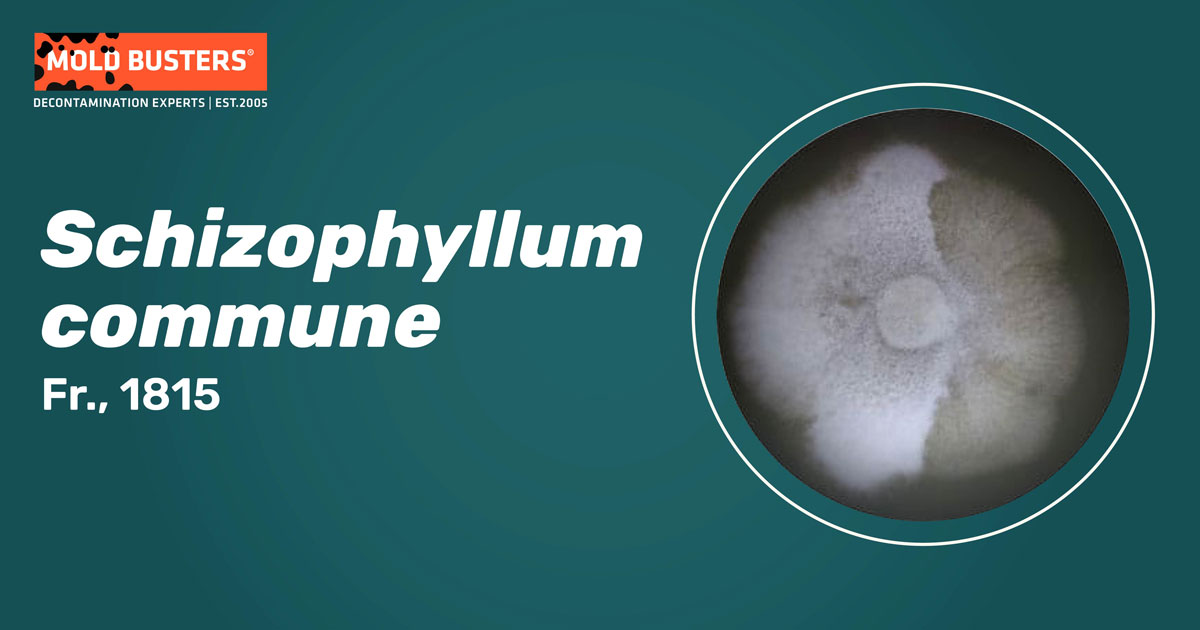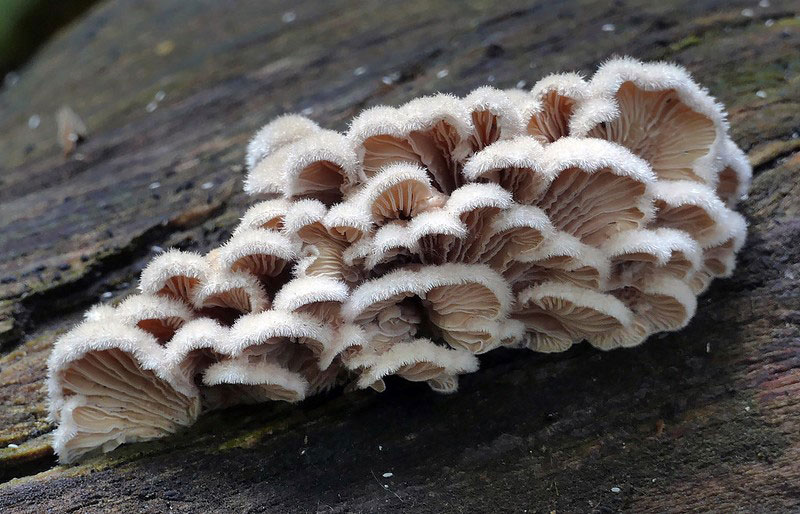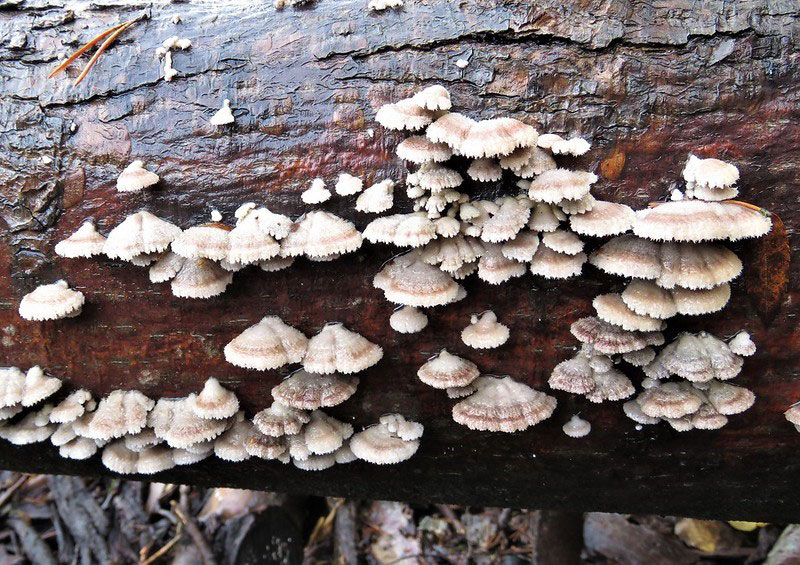Fr., 1815
What is Schizophyllum commune?
Schizophyllum commune, commonly known as Split-gill fungus, is the most famous species of the order Schizophyllales, which belongs to the phylum Basidiomycota. This wood-decaying fungus is ubiquitous, inhabiting every continent except Antarctica, where there is no wood to serve as a substrate [1].
It is also one of the most intensively studied macroscopic fungi globally due to its both therapeutical and harmful properties [1, 2].
How does Schyzophyllum commune look like?
The fruiting bodies of S. commune are fan-shaped, often gregarious, 1-6 cm wide and is, whitish-gray, hairy, and stemless (Fig.1) [1].

Its flesh is inedible, thin, and tough. Gills on the underside are sparse and white to cream [1,3, 4].
Fruiting bodies can be found in clusters on branches, stumps, and logs, with the ability to curl up when dry and rehydrate and release basidiospores when conditions are favorable [1,4].
This is an adaptation to an arid climate with sporadic rains that ensures successful reproduction under unfavorable ecological conditions [1].
Spores are formed on basidia. Each basidia contains 4 cylindrical basidiospores, making the white spore print [1,3]. Spores and 3-4 x 1-1.5 µm in size, smooth walls, and lateral scar at the lower end [5].

(Photo Source: Bernard Spragg)
Schyzophyllum commune ecology
S. commune is a cosmopolitan fungus often found on the bark of dead trees and the dead branches of living trees (Fig. 2). The species causes white wood rot [1, 6]. Due to its invasive nature and ability to colonize wood faster than other wood-rot fungi [1, 6], many researchers consider it a plant pathogen. However, others recognize S. commune as a saprophyte since it colonizes already wounded wood [6].

(Photo Source: Henna K.)
Where can be Schyzophyllum commune found?
Gastronomic and medicinal properties and its resilience to high temperatures make S. commune a very popular food in tropical regions and countries in Asia and Central America. Commercial cultivation of these edible mushrooms has sparked a huge interest in recent decades. In an attempt to find the most economically suitable and environmentally friendly growing media for the cultivation of S. commune in semi-controlled conditions, a wide range of substrates is reported. Substrates are often agricultural by-products, including sawdust of several different wood species [7], banana and coconut leaves [8], pine shavings, dry coffee pulp, maize cobs and stalks, oat and wheat flours, and sunflower shells [9].
Schyzophyllum commune health benefits
The polysaccharide schizophyllan, derived from S. commune, is one of the first three biologically active compounds isolated from medicinal mushrooms [10]. Biologically active polysaccharides are among the most useful obtained from mushrooms since they are very effective in slowing various cancers and other diseases. Their mode of action is based on stimulation of the immune system, making them a far less aggressive option in treating tumors compared to medicines that are destructive to cells. Having cell-level regenerative effects, mushroom polysaccharides, including schizophyllan, reduce the side effects of chemotherapy and radiation therapy [10].
Schizophyllan is now widely used for the treatment of cervical cancer [10]. According to some authors, the consumption of mushrooms with biologically active polysaccharides appears to be helpful in cancer prevention and growth [10].
Antibacterial properties of S. commune extracts are also reported, suggesting antimicrobial activities on Gram-positive bacteria [11].
Numerous studies have demonstrated that regular intake of medicinal mushroom species as a functional food is helpful in both preventing and curing specific illnesses, owing to their immunopotentiation, antibacterial and antioxidant activities [10, 11].
Schyzophyllum commune infection
Although S. commune is considered a great source of nutritive and pharmacologically important compounds, this fungus is one of the most common basidiomycete fungus that causes infections in humans [1, 12]. This fungus can induce various symptoms, ranging from allergic responses to invasive infection, although it is most commonly associated with respiratory infections. Broncho-pulmonary infections and sinusitis account for more than 90% of all cases reported worldwide. Besides respiratory infections, S. commune can cause serious ocular, auricular and cutaneous infections, ulcerative palate lesions, meningitis, abscesses, and fungemia [1, 12].
S. commune [12]. Infection may stay localized or spread from the initial location to other tissues and organs. Spreading of infection depends on numerous factors such as the host’s immunological state, deviation of the nasal septum, usage of corticosteroid treatment, and length of exposure to spores [12]. In immunocompromised patients (mostly patients with underlying diseases including leukemia, lymphoma, myeloma, and diabetes), S. commune tends to cause invasive infections like brain abscesses which can be fatal [12, 13]. However, these kinds of infections are rare.
It is the opinion of some studies that this fungus should be considered in the differential diagnosis of individuals with chronic sinusitis who have failed to respond to conventional treatment [13] Due to lack of familiarity with this fungus and the difficulty of many laboratories in identifying this basidiomycete, infections caused by S. commune are likely to be misdiagnosed or not identified at all [12, 13].
How to treat Schyzophyllum commune?
Considering its omnipresence and invasiveness, S. commune may be causing many more infections than previously assumed. In some chronic infections, surgical interventions are necessary to remove fungus so the identification and susceptibility tests can be performed [12. 13].
The successful treatment of the infection should include preventing and eradicating fungal colonization in the airway, controlling infections caused by fungal exposure, and removing any mucus plugs from the airway [14].
To avoid such complications, the effective management of the fungi from the environment should be performed by competent and equipped professionals, especially during and after humid seasons when the spores of S. commune are abundant in the air.

Did you know?
Stachybotrys is the 2nd common toxic mold type found in homes we tested?! Find out more exciting mold stats and facts on our mold statistics page.
References
- Matavuly et al. (2013). Schizophyllum commune – The Main cause of dying trees of Banja Luka arbored walks and parks. Jour. Nat. Sci, Matica Srpska, Novi Sad. 124: 367-377.
- Chowdhary et al. (2014). Recognizing filamentous basidiomycetes as agents of human disease: A review. Medica Microbiology 52: 782-797.
- Huffman, D. M.; Tiffany, L. H.; Knaphus, G. and Healy R. A. (2008). Mushrooms and Other Fungi of The Midcontinental United States. 2nd The University of Iowa Press, Iowa City. pp 216.
- Carlile, M. J.; Watkinson, S. C., and Gooday, G. W. (2001). The Fungi. Academic Press, San Diego, California. pp 64-65.
- Ellis, D. Schizophyllum commune. Retrieved from adelaide.edu.au
- Takemoto et al. (2010). Schizophyllum commune as a ubiquitous plant parasite. Japan Agricultural Research Quarterly. 44 (4): 357-364.
- Dasanayaka, P. N. and Wijeyaratne, S.C. (2017). Journal of Tropical Forestry and Environment. 7 (1): 65-73.
- Ediriweera et al. (2015). Comparative study of growth and yield of edible mushrooms, Schizophyllum commune, Auricularia polytricha (Mont.) Sacc. and Lentinus squarrosulus Mont. on lignocellulosic substrates. Mycosphere 6 (6): 760-765.
- Garcia et al. (2018). Fruit body production of Schizophyllum commune. Updates of Tropical Mushrooms. Basic and applied research. El Colegio de la Frontera Sur, Chiapas, Mexico. pp 95-104.
- Chang, S. T., and Miles, P. G. (2004). Mushrooms, Cultivation, Nutritional Value, Medicinal Effect, and Environmental Impact. 2nd CRC Press LLC; Boca Raton, Florida. pp 42; 113.
- Miraf et a. (2014). Antimicrobial activities of Split Fill Mushroom Schizophyllum commune American Journal of Research Communication. 2 (4): 113-124.
- Cavana et al. (2019). Human infections due to Schizophyllum commune: Case report and review of the literature. Journal of Medicinal Mycology. 29 (4).
- Premamalini et al. (2014). Schizophyllum commune a causative agent of fungal sinusitis: A Case Report. Case Reports in Infectious Diseases. 2011 (10).
- Ogawa et al. (2013). Implications of high antifungal susceptibility of Schizophyllum commune associated allergy in clinical practice. ASM Journals. 57 (11).
- Figure Featured image: Oliveira MME, Lemos AS, Gonçalves MLC, Almeida-Paes R, Valviesse VRGdA, Moreira JA, et al. (2017) Fungemia associated with Schizophyllum commune in Brazil. PLoS Negl Trop Dis 11(6): e0005549. Available from doi.org

Get Special Gift: Industry-Standard Mold Removal Guidelines
Download the industry-standard guidelines that Mold Busters use in their own mold removal services, including news, tips and special offers:

Written by:
Jelena Somborski
Mycologist
Mold Busters
Edited by:
Dusan Sadikovic
Mycologist – MSc, PhD
Mold Busters
